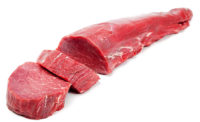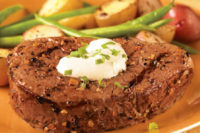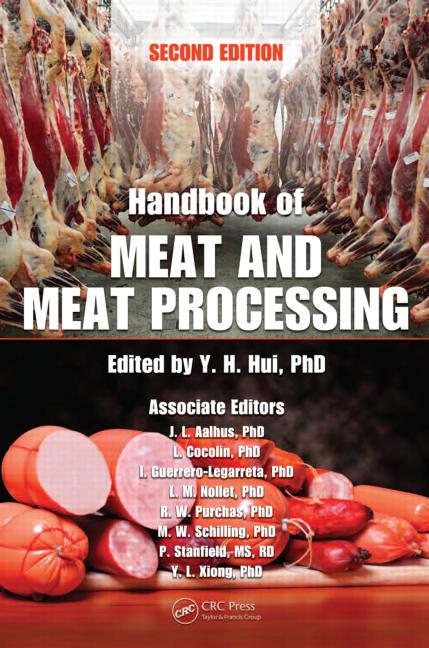The greatest challenge whole-muscle product processors face daily is the natural size and shape variation inherent in any whole-muscle product and process.
For example, consistently during the past 20 years, respondents to the National Beef Quality Audits say variation in animal size is one of the major impediments to the industry, says Davey Griffin professor and extension meat specialist with Texas A&M Agriculture and Life Sciences, in College Station.
“When we do the Quality Audit, we see an increase in carcass size, which goes back to the life size,” he says. “With the variation that we see, they’re not all large. So the variation we see, but especially as they get larger, starts to really put a demand on both equipment and people and also what some end user might be able to do with the product.”
One of Dallas-based Standard Meat Co.’s main goals as a portion-control operation is to provide its customers and thus the consumer with a consistent product, not only in weight but in dimensional characteristics as well, says Kyle Pfeiffer, the company’s director of science and innovation.
“The large amount of variation that we see in each case of raw material makes this a challenge,” he explains. “The variations that are present from piece to piece can also limit our ability to automate and use technologies that may be commonplace in grind or forming operations where these metrics can be highly controlled.”
Automation continues to grow in whole-muscle processing, though, to aid employees in doing their jobs better, Griffin says. Automation is both economically and ergonomically helping processors by making fabrication not so physically demanding on employees, particularly from the standpoint of cuts being larger. Using automation in plants is still challenged, though, by variation in carcass sizes in addition to operating in cold, damp environments, Griffin says.
“There’s been a lot of neat things that I’ve seen going in plants that is really high tech in some areas in what they’re doing in trying to achieve both for worker safety and worker convenience and speed of what they do,” Griffin says. “Most of those plants work on really small margins, but they are high volume. Throughput really makes a difference in whether they’re economically making this work or not.”
Whole-muscle snacks
As a company that uses whole-muscle proteins, historically it was challenging for Expresco Foods — a Montreal, Quebec, processor — to compete with companies whose products were more processed and cost less. Now with the demand for cleaner, better-for-you meat products, Michael Delli Colli, marketing manager of Expresco Foods, sees whole-muscle products growing, particularly in the meat snacks category where the company’s ProSticks, grilled chicken skewers, are sold in snack-size pouches compete.
Efficiencies in whole-muscle processing, such as improvements in yield, also have helped ease costs for the company. For example trimming has become costly with larger size birds. The more time processors manually trim something, the less money a company can make.
“Our ProSticks, or any skewered meat, the closer we are to our target weight, obviously the better yield we are going to have and the more efficient we are and the more product we can make and get out of the building,” Delli Colli says.
Moving forward, Delli Colli sees strong relationships with its suppliers will be paramount to compete in the whole-muscle protein market. “Consumer demand is that they want to know more about the story of the product, how clean the product is, the fact that it is a whole-muscle product and it’s low in fat,” he explains. “They want to know a lot about protein levels.”
Consumer friendly cuts
The continual increase in animal, and therefore carcass, weights presents an issue as well as it pertains to steak thickness, especially when combined with the reduction in portion weights that the industry has seen as a consumer trend.
“Thinner steaks not only can be perceived by the consumer as lower quality, but can also be a challenge to accurately deliver on consumers’ desired degree of doneness,” Pfeiffer says.
Research continues to be conducted by National Cattlemen’s Beef Association and others to address these challenges, mainly focusing on alternative cutting methods that can mitigate the effect of larger subprimals. “These campaigns should always include a consumer marketing/educational piece as many of the resultant cuts would not be recognizable to the average beef eater,” Pfeiffer says.
For example, packers can take cuts such as the shoulder clod, which can be a 20- to 25-pound cut, and break the piece down into muscles that have different eating qualities, Griffin says. For instance, the top blade could be sold as flat iron steak. “Used to be the only way you could get those were you had to buy a whole shoulder clod,” he explains. “Now, you can buy the top blades by themselves.”
The large size of ribeyes today offers another example of how processors are innovating with new cuts.
“The size of some of those ribeyes being, just so large, to cut a 1-inch steak off of them now that weighs too much even at a retail store for the price point on the package and it’s certainly too big for most food-service operations that are cutting by the ounce,” Griffin explains. “If you are cooking a 10-ounce ribeye steak, it might be just a very thin cut. If we cut that really big ribeye, but if we take the ribeye cap off of that and take a couple of other peripheral muscles off, there’s ways to cut the thinner portion of that into ribeye filets that are now thick and just not as big around. They look more like a filet. Or using that ribeye cap, which is really succulently tender and juicy and flavorful, and using it as a new steak by itself.”
“We’re starting to literally use individual muscles, when it gets right down to it, and really targeting those for their best outcome, best usage and not putting them in big cuts that most consumers don’t want today anyway,” Griffin adds. “The industry now is in a position to really make those cuts and provide a product that a food company could use more than we used to when we were pretty much supplying carcasses.”
Moving forward, Griffin believes the industry will continue to use more individual muscles and having those targeted for further processing use.
“As we go along, I think more and more of that is happening at larger facilities not just at a further processing facility where then they have to figure out how to use the trimmings or things that come off of it to make that cut where they can be used in more volume back at the packing plant,” Griffin says.
Technology also continues to advance with whole-muscle processing.
“For us it is the continual use of ever advancing technologies, whether it is vision-based automated portioning systems, robotics or various other technologies that allow us to mitigate increasing labor costs,” Pfeiffer says.
As automation technology becomes more advanced and flexible, it will also become more viable in this sector of the industry. “What we can’t utilize is technology that only works with a perfectly formed hamburger patty or sausage links,” Pfeiffer says. “Technology solutions in our industry must be flexible enough to manage the lack of a consistent incoming raw material.” NP










Report Abusive Comment